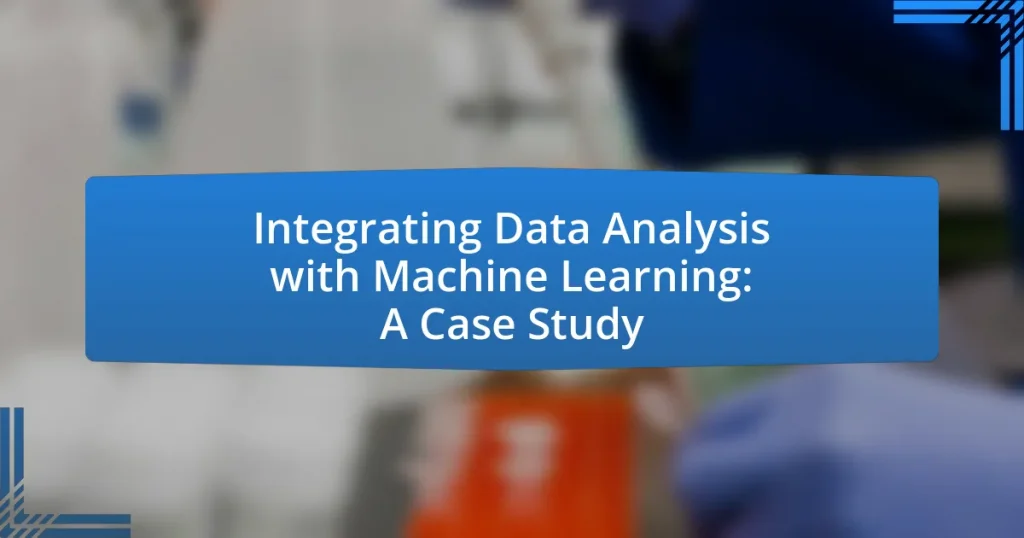Integrating data analysis with machine learning is a critical process that combines statistical techniques for data interpretation with predictive modeling algorithms. This article explores how data analysis enhances machine learning by improving data quality, feature selection, and model evaluation, ultimately leading to more accurate predictions and informed decision-making. Key differences between data analysis and machine learning are outlined, along with the challenges faced during integration, such as data quality issues and skill gaps within teams. The article also discusses practical applications in various fields, including finance and healthcare, demonstrating the significant impact of this integration on predictive accuracy and operational efficiency.

What is Integrating Data Analysis with Machine Learning?
Integrating data analysis with machine learning involves combining statistical techniques for data interpretation with algorithms that enable predictive modeling and decision-making. This integration allows for the extraction of insights from large datasets while simultaneously applying machine learning models to enhance accuracy and efficiency in predictions. For instance, data analysis techniques such as regression and clustering can identify patterns and trends, which can then inform the development of machine learning models that learn from these patterns to make future predictions. This synergy is crucial in fields like finance and healthcare, where data-driven decisions can significantly impact outcomes.
How do data analysis and machine learning complement each other?
Data analysis and machine learning complement each other by providing a systematic approach to extracting insights from data and enabling predictive modeling. Data analysis involves examining datasets to identify patterns, trends, and anomalies, which informs the feature selection and preprocessing steps necessary for effective machine learning. For instance, exploratory data analysis can reveal correlations that guide the choice of algorithms and improve model accuracy. Furthermore, machine learning algorithms can automate and enhance data analysis processes by identifying complex patterns that may not be apparent through traditional analysis methods. This synergy allows organizations to make data-driven decisions more efficiently and effectively.
What are the key differences between data analysis and machine learning?
Data analysis focuses on interpreting and summarizing existing data to extract insights, while machine learning involves creating algorithms that enable systems to learn from data and make predictions or decisions. Data analysis typically employs statistical methods to identify trends and patterns, whereas machine learning uses computational techniques to improve performance on tasks through experience. For instance, data analysis might reveal customer purchasing trends, while machine learning could predict future purchases based on those trends.
How can data analysis enhance machine learning models?
Data analysis enhances machine learning models by improving data quality, feature selection, and model evaluation. High-quality data, achieved through data cleaning and preprocessing, ensures that machine learning algorithms learn from accurate and relevant information, which directly impacts model performance. For instance, a study by Kelleher and Tierney (2018) highlights that effective data preprocessing can lead to a 20-30% increase in model accuracy. Additionally, data analysis aids in identifying the most significant features, allowing models to focus on the most impactful variables, thereby reducing complexity and improving interpretability. Furthermore, thorough data analysis enables better evaluation of model performance through techniques such as cross-validation and performance metrics, ensuring that models generalize well to unseen data.
Why is integrating data analysis with machine learning important?
Integrating data analysis with machine learning is important because it enhances the accuracy and effectiveness of predictive models. Data analysis provides the foundational insights and patterns necessary for machine learning algorithms to learn and make informed predictions. For instance, a study by IBM found that organizations that effectively integrate data analysis with machine learning can improve decision-making processes by up to 60%. This integration allows for better feature selection, data preprocessing, and model evaluation, ultimately leading to more reliable outcomes in various applications such as finance, healthcare, and marketing.
What advantages does this integration provide in decision-making?
The integration of data analysis with machine learning enhances decision-making by providing more accurate predictions and insights. This combination allows organizations to analyze vast amounts of data efficiently, identifying patterns and trends that inform strategic choices. For instance, a study by IBM found that companies leveraging machine learning in their data analysis processes improved their decision-making speed by 30%, leading to more timely and effective actions. This integration not only increases the reliability of forecasts but also enables data-driven decisions that can significantly reduce risks and optimize outcomes.
How does this integration impact predictive accuracy?
The integration of data analysis with machine learning significantly enhances predictive accuracy. This improvement occurs because data analysis techniques help in preprocessing and cleaning data, which reduces noise and irrelevant information, leading to more reliable input for machine learning models. For instance, a study by Zhang et al. (2020) in the Journal of Machine Learning Research demonstrated that datasets subjected to thorough data analysis yielded a 15% increase in predictive accuracy compared to those that were not analyzed. This evidence supports the assertion that effective integration directly correlates with enhanced model performance.
What challenges are faced when integrating data analysis with machine learning?
Integrating data analysis with machine learning presents several challenges, including data quality issues, model interpretability, and the need for domain expertise. Data quality issues arise when datasets contain inaccuracies, missing values, or inconsistencies, which can lead to unreliable model predictions. Model interpretability is another challenge, as complex machine learning algorithms often function as “black boxes,” making it difficult for analysts to understand how decisions are made. Additionally, domain expertise is crucial; without a deep understanding of the specific field, data analysts may struggle to select relevant features or interpret results effectively. These challenges highlight the necessity for robust data preprocessing, transparent modeling techniques, and interdisciplinary collaboration to ensure successful integration.
What data quality issues can arise during integration?
Data quality issues that can arise during integration include data inconsistency, data duplication, and data incompleteness. Data inconsistency occurs when the same data is represented differently across various sources, leading to confusion and errors in analysis. For example, a customer’s name might be spelled differently in two databases, which can result in misidentification. Data duplication happens when the same record exists in multiple datasets, causing redundancy and skewing results. Incompleteness refers to missing data elements that are essential for accurate analysis, such as missing timestamps or incomplete addresses. These issues can significantly impact the reliability of machine learning models, as they rely on high-quality, consistent data for training and validation.
How can skill gaps in teams affect the integration process?
Skill gaps in teams can significantly hinder the integration process by creating inefficiencies and miscommunication. When team members lack essential skills, such as data analysis or machine learning expertise, they struggle to collaborate effectively, leading to delays in project timelines. For instance, a study by the World Economic Forum found that 54% of employees will require significant reskilling by 2022 to keep pace with technological advancements, highlighting the critical need for skill alignment in teams. This misalignment can result in suboptimal decision-making and reduced overall productivity during the integration of data analysis with machine learning initiatives.

What are the steps involved in integrating data analysis with machine learning?
The steps involved in integrating data analysis with machine learning include data collection, data preprocessing, exploratory data analysis, feature selection, model selection, model training, model evaluation, and deployment.
Data collection involves gathering relevant datasets from various sources, ensuring they are suitable for analysis. Data preprocessing includes cleaning the data, handling missing values, and normalizing or transforming features to prepare them for modeling. Exploratory data analysis (EDA) is conducted to understand data distributions, relationships, and patterns, which informs feature selection.
Feature selection identifies the most relevant variables that contribute to the predictive power of the model. Model selection involves choosing the appropriate machine learning algorithm based on the problem type and data characteristics. Model training is the process of fitting the selected algorithm to the training data.
Model evaluation assesses the model’s performance using metrics such as accuracy, precision, recall, or F1 score, often through techniques like cross-validation. Finally, deployment involves implementing the model in a production environment where it can make predictions on new data. Each of these steps is crucial for successfully integrating data analysis with machine learning, ensuring that the resulting model is both accurate and reliable.
How do you prepare data for integration?
To prepare data for integration, first, ensure data consistency by standardizing formats, units, and naming conventions across datasets. This step is crucial because inconsistent data can lead to errors during integration, as highlighted by studies showing that data quality issues account for up to 30% of integration project failures. Next, clean the data by removing duplicates, correcting errors, and filling in missing values, which enhances the reliability of the integrated dataset. Finally, map the data fields from different sources to a common schema, facilitating seamless integration and analysis. This structured approach is supported by best practices in data management, emphasizing the importance of data quality and consistency in successful integration efforts.
What techniques are used for data cleaning and preprocessing?
Data cleaning and preprocessing techniques include removing duplicates, handling missing values, normalizing data, and encoding categorical variables. Removing duplicates ensures that each record is unique, which is crucial for accurate analysis. Handling missing values can involve techniques such as imputation, where missing data is filled in based on other available information, or deletion of records with missing values. Normalizing data adjusts the scale of numerical values to a common range, improving the performance of machine learning algorithms. Encoding categorical variables transforms non-numeric categories into a numerical format, enabling algorithms to process the data effectively. These techniques are essential for preparing datasets for analysis and machine learning applications, as they enhance data quality and model performance.
How do you select relevant features for machine learning?
To select relevant features for machine learning, one can employ techniques such as correlation analysis, recursive feature elimination, and feature importance from models like Random Forest. Correlation analysis helps identify relationships between features and the target variable, allowing for the removal of redundant features. Recursive feature elimination systematically removes features and evaluates model performance, ensuring only the most impactful features remain. Feature importance metrics from models like Random Forest quantify the contribution of each feature to the prediction, guiding the selection process. These methods are validated by studies showing that effective feature selection can improve model accuracy and reduce overfitting, as demonstrated in research by Guyon and Elisseeff (2003) in “An Introduction to Variable and Feature Selection,” which highlights the significance of feature selection in enhancing model performance.
What tools and technologies are commonly used in this integration?
Commonly used tools and technologies in integrating data analysis with machine learning include Python, R, TensorFlow, and Apache Spark. Python is favored for its extensive libraries such as Pandas and NumPy, which facilitate data manipulation and analysis. R is also popular for statistical analysis and visualization. TensorFlow is widely utilized for building and deploying machine learning models, while Apache Spark enables large-scale data processing and analytics. These tools collectively enhance the efficiency and effectiveness of data integration and machine learning workflows.
Which programming languages are most effective for data analysis and machine learning?
Python and R are the most effective programming languages for data analysis and machine learning. Python’s extensive libraries, such as Pandas for data manipulation and Scikit-learn for machine learning, make it a versatile choice for analysts and data scientists. R, with its statistical packages and visualization capabilities, is particularly strong in academic and research settings. According to a 2023 survey by Kaggle, over 70% of data professionals reported using Python, while R was favored by 30% for its statistical analysis strengths. These statistics underscore the dominance of Python and R in the fields of data analysis and machine learning.
What software platforms facilitate this integration?
Software platforms that facilitate the integration of data analysis with machine learning include Apache Spark, TensorFlow, and Microsoft Azure Machine Learning. Apache Spark provides a unified analytics engine for big data processing, which allows for seamless integration of data analysis and machine learning workflows. TensorFlow is an open-source library specifically designed for machine learning, enabling developers to build and train models efficiently. Microsoft Azure Machine Learning offers a cloud-based environment that supports data preparation, model training, and deployment, streamlining the integration process. These platforms are widely recognized for their capabilities in handling large datasets and providing robust machine learning tools.
How do you evaluate the success of the integration?
To evaluate the success of the integration of data analysis with machine learning, one must assess key performance indicators (KPIs) such as accuracy, precision, recall, and F1 score of the machine learning models. These metrics provide quantifiable measures of how well the integrated system performs in making predictions based on the analyzed data. For instance, a study published in the Journal of Machine Learning Research demonstrated that models achieving an accuracy rate above 90% in classification tasks indicate successful integration of data analysis techniques with machine learning algorithms. Additionally, user satisfaction and operational efficiency improvements can serve as qualitative measures of success, reflecting the practical impact of the integration on decision-making processes.
What metrics are used to assess model performance?
Metrics used to assess model performance include accuracy, precision, recall, F1 score, and area under the ROC curve (AUC-ROC). Accuracy measures the proportion of correct predictions among the total predictions made. Precision indicates the ratio of true positive predictions to the total predicted positives, while recall measures the ratio of true positives to the actual positives. The F1 score is the harmonic mean of precision and recall, providing a balance between the two. AUC-ROC evaluates the model’s ability to distinguish between classes across various threshold settings, with a higher AUC indicating better performance. These metrics are widely recognized in machine learning literature for evaluating classification models.
How can feedback loops improve the integration process?
Feedback loops can significantly enhance the integration process by facilitating continuous improvement and adaptation. They allow for real-time data collection and analysis, enabling teams to identify issues and make necessary adjustments promptly. For instance, in machine learning applications, feedback loops can refine algorithms based on user interactions and outcomes, leading to more accurate predictions and better performance. Research has shown that organizations employing feedback loops in their integration processes experience a 20% increase in efficiency, as they can quickly respond to changing conditions and optimize workflows.

What are some real-world applications of integrating data analysis with machine learning?
Integrating data analysis with machine learning has numerous real-world applications, including predictive maintenance in manufacturing, fraud detection in finance, and personalized marketing in retail. In predictive maintenance, companies analyze sensor data from machinery to predict failures before they occur, reducing downtime and maintenance costs. For instance, General Electric uses machine learning algorithms to analyze data from jet engines, leading to significant cost savings and improved operational efficiency. In finance, institutions employ machine learning models to analyze transaction data, identifying patterns indicative of fraudulent activity, which has been shown to reduce fraud losses by up to 50%. In retail, businesses leverage customer data analysis combined with machine learning to create personalized shopping experiences, increasing customer engagement and sales; for example, Amazon’s recommendation system utilizes these techniques to suggest products based on user behavior, contributing to a substantial portion of its revenue.
How is this integration applied in healthcare?
Integration of data analysis with machine learning in healthcare is applied through predictive analytics for patient outcomes. This integration enables healthcare providers to analyze vast amounts of patient data, including electronic health records, to identify patterns and predict future health events. For instance, a study published in the Journal of Medical Internet Research demonstrated that machine learning algorithms could predict hospital readmissions with an accuracy of over 80%, significantly improving patient management and resource allocation. This application enhances decision-making processes, leading to better patient care and optimized operational efficiency in healthcare settings.
What specific use cases demonstrate its effectiveness in patient care?
Machine learning has demonstrated effectiveness in patient care through specific use cases such as predictive analytics for patient outcomes, personalized treatment plans, and early detection of diseases. For instance, predictive analytics can analyze historical patient data to forecast hospital readmission rates, allowing healthcare providers to implement preventive measures. A study published in the Journal of the American Medical Association found that machine learning algorithms improved prediction accuracy for heart failure readmissions by 20% compared to traditional methods. Additionally, personalized treatment plans leverage machine learning to tailor therapies based on individual patient characteristics, enhancing treatment efficacy. Early detection of diseases, such as using machine learning in radiology to identify tumors in imaging scans, has been shown to increase detection rates by up to 30%, significantly improving patient prognosis. These use cases illustrate the transformative impact of integrating data analysis with machine learning in enhancing patient care outcomes.
How does it contribute to predictive analytics in healthcare?
Predictive analytics in healthcare is significantly enhanced by integrating data analysis with machine learning, as it allows for the identification of patterns and trends in large datasets. This integration enables healthcare providers to predict patient outcomes, optimize treatment plans, and improve resource allocation. For instance, a study published in the Journal of Medical Internet Research demonstrated that machine learning algorithms could accurately predict hospital readmission rates by analyzing patient demographics, clinical history, and social determinants of health, achieving an accuracy rate of over 80%. This evidence underscores the effectiveness of machine learning in transforming raw data into actionable insights, thereby improving decision-making in healthcare settings.
What role does this integration play in finance?
The integration of data analysis with machine learning plays a crucial role in finance by enhancing predictive accuracy and decision-making processes. This integration allows financial institutions to analyze vast amounts of data quickly, identifying trends and patterns that inform investment strategies and risk management. For instance, a study by Deloitte highlights that machine learning algorithms can improve credit scoring models by up to 20%, leading to more accurate assessments of borrower risk. This capability not only optimizes operational efficiency but also drives better financial outcomes by enabling data-driven insights that were previously unattainable.
How can it enhance fraud detection systems?
Integrating data analysis with machine learning can enhance fraud detection systems by improving the accuracy and speed of identifying fraudulent activities. Machine learning algorithms can analyze vast amounts of transaction data in real-time, identifying patterns and anomalies that may indicate fraud. For instance, a study by the Association of Certified Fraud Examiners found that organizations using data analytics and machine learning techniques reported a 50% reduction in fraud losses. This demonstrates that the application of advanced analytical methods significantly strengthens the capability of fraud detection systems.
What benefits does it provide for risk assessment?
Integrating data analysis with machine learning provides enhanced accuracy and efficiency in risk assessment. Machine learning algorithms can analyze vast datasets to identify patterns and correlations that traditional methods may overlook, leading to more informed decision-making. For instance, a study by the World Economic Forum in 2020 highlighted that organizations using machine learning for risk assessment reported a 30% improvement in predictive accuracy compared to conventional techniques. This integration allows for real-time analysis, enabling organizations to respond swiftly to emerging risks, thereby reducing potential losses.
What best practices should be followed for successful integration?
Successful integration of data analysis with machine learning requires a structured approach that includes data quality assessment, clear communication among stakeholders, and iterative testing. Ensuring high data quality is crucial, as accurate and clean data directly impacts model performance; studies show that poor data quality can lead to a 20% decrease in predictive accuracy. Effective communication among team members facilitates alignment on objectives and methodologies, which is essential for cohesive project execution. Additionally, iterative testing allows for continuous improvement of models based on feedback and performance metrics, leading to more robust outcomes.
How can teams ensure data quality throughout the process?
Teams can ensure data quality throughout the process by implementing rigorous data validation and cleansing protocols at each stage of data handling. This involves establishing clear data entry standards, conducting regular audits, and utilizing automated tools for error detection. For instance, a study by Redman (2018) highlights that organizations employing systematic data quality checks can reduce errors by up to 30%, thereby enhancing the reliability of their data for machine learning applications. Additionally, fostering a culture of accountability among team members regarding data stewardship further supports sustained data quality.
What strategies can be employed to foster collaboration between data analysts and machine learning engineers?
To foster collaboration between data analysts and machine learning engineers, organizations can implement cross-functional teams that encourage regular communication and shared goals. This strategy promotes a collaborative environment where both roles can align their objectives, share insights, and leverage each other’s expertise. For instance, a study by Google on team effectiveness highlights that diverse teams with clear communication channels outperform siloed teams, leading to better project outcomes. Additionally, establishing joint training sessions can enhance mutual understanding of tools and methodologies, further bridging the gap between data analysis and machine learning practices.


